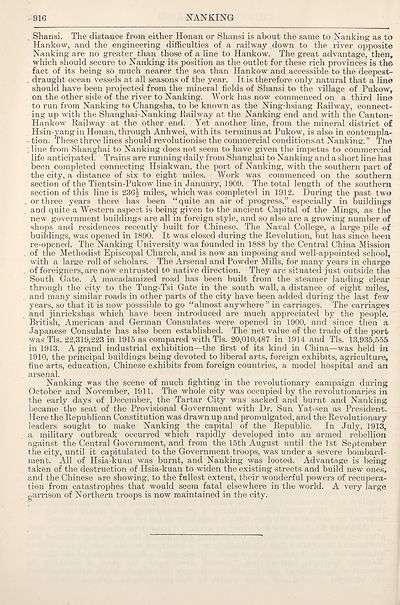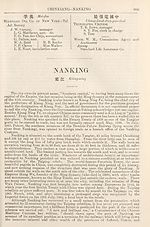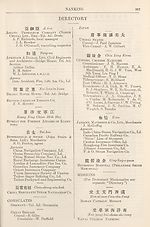1917
(1018) Page 916
Download files
Complete book:
Individual page:
Thumbnail gallery: Grid view | List view

916
NANKING
. Shansi. The distance from either Honan or Shansi is about the same to Nanking as to
Hankow, and the engineering difficulties of a railway down to the river opposite
Nanking are no greater than those of a line to Hankow. The great advantage, then,
which should secure to Nanking its position as the outlet for these rich provinces is the
fact of its being so much nearer the sea than Hankow and accessible to the deepest-
. draught ocean vessels at all seasons of the year. It is therefore only natural that a line
should have been projected from the mineral fields of Shansi to the village of Pukow,
on the other side of the river to Nanking. Work has now commenced on a third line
to run from Nanking to Changsha, to be known as the Ning-hsiang Railway, connect¬
ing up with the Shanghai-Nanking Railway at the Nanking end and with the Canton-
Hankow Railway at the other end. Yet another line, from the mineral district of
Hsin-jrang in Honan, through Anhwei, with its terminus at Pukow, is also in contempla-
• tion. These three lines should revolutionise the commercial conditions at Nanking.” The
■ line from Shanghai to Nanking does not seem to have given the impetus to commercial
life anticipated. Trains are running daily from Shanghai to Nanking and a short line has
been completed connecting Hsiakwan, the port of Nanking, with the southern part of
the city, a distance of six to eight miles. Work was commenced on the southern
section of the Tientsin-Pukow line in January, 1909. The total length of the southern
section of this line is 236^ miles, which was completed in 1912. During the past two
or three years there has been “quite an air of progress,” especially in buildings
and quite a Western aspect is being given to the ancient Capital of the Mings, as the
new government buildings are all in foreign style, and so also are a growing number of
shops and residences recently built for Chinese. The Naval College, a large pile of
buildings, was opened in 1890. It was closed during the Revolution, but has since been
re-opened. The Nanking University was founded in 1888 by the Central China Mission
of the Methodist Episcopal Church, and is now an imposing and well-appointed school,
with a large roll of scholars. The Arsenal and Powder Mills, for many years in charge
of foreigners, are now entrusted to native direction. They are situated just outside the
South Gate. A macadamized road has been built from the steamer landing clear
through the city to the Tung-Tsi Gate in the south wall, a distance of eight miles,
and many similar roads in other parts of the city have been added during the last few
years, so that it is now posssible to go “almost anywhere” in carriages. The carriages
and jinrickshas which have been introduced are much appreciated by the people.
British, American and German Consulates were opened in 1900, and since then a
Japanese Consulate has also been established. The net value of the trade of the port
was Tls. 22,319,223 in 1915 as compared with Tls. 20,010,487 in 1914 and Tls. 13,935,555
in 1913. A grand industrial exhibition—the first of its kind in China—was held in
1910, the principal buildings being devoted to liberal arts, foreign exhibits, agriculture,
fine arts, education, Chinese exhibits from foreign countries, a model hospital and an
arsenal.
Nanking was the scene of much fighting in the revolutionary campaign during
October and November, 1911. The whole city was occupied by the revolutionaries in
the early days of December, the Tartar City was sacked and burnt and Nanking
became the seat of the Provisional Government with Dr. Sun Yat-sen as President.
Here the Republican Constitution was drawn up and promulgated, and the Revolutionary
leaders sought to make Nanking the capital of the Republic. In July, 1913,
a military outbreak occurred which rapidly developed into an armed rebellion
against the Central Government, and from the 15th August until the 1st September
the city, until it capitulated to the Government troops, was under a severe bombard¬
ment. All of Hsia-kuan was burnt, and Nanking was looted. Advantage is being
taken of the destruction of Hsia-kuan to widen the existing streets and build new ones,
and the Chinese are showing, to the fullest extent, their wonderful powers of recupera¬
tion from catastrophes that would seem fatal elsewhere in the world. A very large
garrison of Northern troops is now maintained in the city.
NANKING
. Shansi. The distance from either Honan or Shansi is about the same to Nanking as to
Hankow, and the engineering difficulties of a railway down to the river opposite
Nanking are no greater than those of a line to Hankow. The great advantage, then,
which should secure to Nanking its position as the outlet for these rich provinces is the
fact of its being so much nearer the sea than Hankow and accessible to the deepest-
. draught ocean vessels at all seasons of the year. It is therefore only natural that a line
should have been projected from the mineral fields of Shansi to the village of Pukow,
on the other side of the river to Nanking. Work has now commenced on a third line
to run from Nanking to Changsha, to be known as the Ning-hsiang Railway, connect¬
ing up with the Shanghai-Nanking Railway at the Nanking end and with the Canton-
Hankow Railway at the other end. Yet another line, from the mineral district of
Hsin-jrang in Honan, through Anhwei, with its terminus at Pukow, is also in contempla-
• tion. These three lines should revolutionise the commercial conditions at Nanking.” The
■ line from Shanghai to Nanking does not seem to have given the impetus to commercial
life anticipated. Trains are running daily from Shanghai to Nanking and a short line has
been completed connecting Hsiakwan, the port of Nanking, with the southern part of
the city, a distance of six to eight miles. Work was commenced on the southern
section of the Tientsin-Pukow line in January, 1909. The total length of the southern
section of this line is 236^ miles, which was completed in 1912. During the past two
or three years there has been “quite an air of progress,” especially in buildings
and quite a Western aspect is being given to the ancient Capital of the Mings, as the
new government buildings are all in foreign style, and so also are a growing number of
shops and residences recently built for Chinese. The Naval College, a large pile of
buildings, was opened in 1890. It was closed during the Revolution, but has since been
re-opened. The Nanking University was founded in 1888 by the Central China Mission
of the Methodist Episcopal Church, and is now an imposing and well-appointed school,
with a large roll of scholars. The Arsenal and Powder Mills, for many years in charge
of foreigners, are now entrusted to native direction. They are situated just outside the
South Gate. A macadamized road has been built from the steamer landing clear
through the city to the Tung-Tsi Gate in the south wall, a distance of eight miles,
and many similar roads in other parts of the city have been added during the last few
years, so that it is now posssible to go “almost anywhere” in carriages. The carriages
and jinrickshas which have been introduced are much appreciated by the people.
British, American and German Consulates were opened in 1900, and since then a
Japanese Consulate has also been established. The net value of the trade of the port
was Tls. 22,319,223 in 1915 as compared with Tls. 20,010,487 in 1914 and Tls. 13,935,555
in 1913. A grand industrial exhibition—the first of its kind in China—was held in
1910, the principal buildings being devoted to liberal arts, foreign exhibits, agriculture,
fine arts, education, Chinese exhibits from foreign countries, a model hospital and an
arsenal.
Nanking was the scene of much fighting in the revolutionary campaign during
October and November, 1911. The whole city was occupied by the revolutionaries in
the early days of December, the Tartar City was sacked and burnt and Nanking
became the seat of the Provisional Government with Dr. Sun Yat-sen as President.
Here the Republican Constitution was drawn up and promulgated, and the Revolutionary
leaders sought to make Nanking the capital of the Republic. In July, 1913,
a military outbreak occurred which rapidly developed into an armed rebellion
against the Central Government, and from the 15th August until the 1st September
the city, until it capitulated to the Government troops, was under a severe bombard¬
ment. All of Hsia-kuan was burnt, and Nanking was looted. Advantage is being
taken of the destruction of Hsia-kuan to widen the existing streets and build new ones,
and the Chinese are showing, to the fullest extent, their wonderful powers of recupera¬
tion from catastrophes that would seem fatal elsewhere in the world. A very large
garrison of Northern troops is now maintained in the city.
Set display mode to:
![]() Universal Viewer |
Universal Viewer | ![]() Mirador |
Large image | Transcription
Mirador |
Large image | Transcription
Images and transcriptions on this page, including medium image downloads, may be used under the Creative Commons Attribution 4.0 International Licence unless otherwise stated. ![]()
| Asian directories and chronicles > 1917 > (1018) Page 916 |
|---|
| Permanent URL | https://digital.nls.uk/194545542 |
|---|
| Attribution and copyright: |
|
|---|---|
| Description | Volumes from the Asian 'Directory and Chronicle' series covering 1917-1941, but missing 1919 and 1923. Compiled annually from a multiplicity of local sources and research. They provide listings of each country's active corporations, foreign residents and government agencies of all nationalities for that year, together with their addresses. Content includes: various treaties; coverage of conflicts; currencies and taxes; consular fees; weights and measures; public holidays; festivals and traditions. A source of information for both Western states and communities of foreigners living in Asia. Published by Hongkong Daily Press. |
|---|---|
| Shelfmark | H3.86.1303 |
| Additional NLS resources: |

